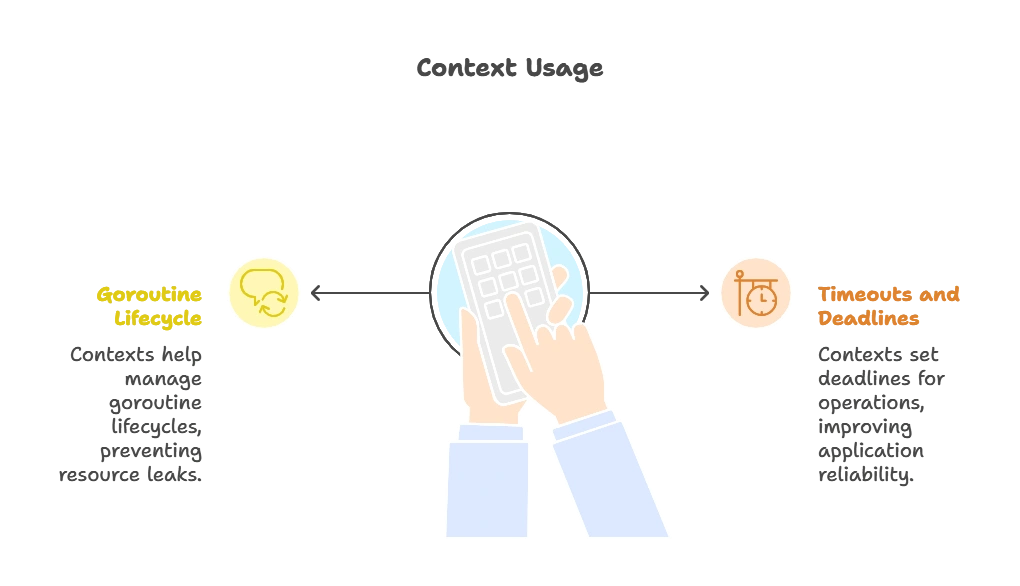Context Package for Handling Cancellation
In Go programming, managing concurrency is essential, especially when dealing with multiple goroutines. The context package is a powerful tool that helps developers manage goroutine lifecycle, handle cancellations, and set deadlines effectively. Understanding its fundamentals is crucial for writing robust and scalable concurrent applications.
Why Use Context?
Goroutine Lifecycle Management
- Goroutines are lightweight threads in Go, and managing their lifecycle is critical for resource efficiency.
- Contexts provide a standardized way to signal cancellation and propagate it through the goroutine tree, ensuring timely cleanup and prevention of resource leaks.
Timeouts and Deadlines
- Setting deadlines for operations is essential to prevent them from blocking indefinitely, especially in network operations or I/O-bound tasks.
- Contexts allow developers to specify how long an operation should run before being considered as timed out, thus improving application reliability.

Basic Concepts of Context
Context Type
The context.Context type serves as a carrier for deadlines, cancellation signals, and other request-scoped values.
It is the cornerstone of context management in Go and is used to propagate information across goroutines.
Creating Contexts
The context.Background() function creates a base context that serves as the root of a context tree.
Contexts with deadlines can be created using context.WithTimeout(parent, timeout) or context.WithDeadline(parent, deadline).
Managing Goroutines with Context
Passing Contexts
Contexts are passed explicitly as parameters to functions that need them.
They propagate through the call stack, ensuring that all relevant operations are aware of the context’s deadline or cancellation signal.
Context-Based Cancellation
The context.WithCancel(parent) function creates a child context with a cancellation function.
Calling this cancellation function signals all goroutines associated with the context to cancel their work, promoting graceful shutdowns.
Advanced Usage of Context
Value Propagation
context.WithValue(parent, key, value) allows attaching request-scoped values to a context.
These values can be accessed by functions down the call stack, making them useful for passing request-specific data, such as user authentication tokens.
Select Statement with Context
Contexts can be integrated with the select statement to wait on multiple operations concurrently.
This enables efficient handling of context cancellations along with other channel operations within a single select block.
package main
import (
"context"
"fmt"
"time"
)
func worker(ctx context.Context, key string) {
for {
select {
case <-ctx.Done():
fmt.Printf("Worker for key '%s': Context cancelled. Exiting...\n", key)
return
default:
// Accessing value from context
if value := ctx.Value(key); value != nil {
fmt.Printf("Worker for key '%s': Processing value: %v\n", key, value)
}
time.Sleep(1 * time.Second)
}
}
}
func main() {
// Create a parent context
parentCtx := context.Background()
// Create a context with cancellation
ctx, cancel := context.WithCancel(parentCtx)
// Pass request-scoped value
ctxWithValue := context.WithValue(ctx, "userID", 123)
// Start workers
go worker(ctxWithValue, "userID")
// Simulate cancellation after 3 seconds
time.Sleep(3 * time.Second)
cancel()
fmt.Println("Main: Context cancelled. Exiting...")
}
- We create a parent context
parentCtxusingcontext.Background(). - We create a child context
ctxusingcontext.WithCancel(parentCtx), which provides a cancellation functioncancel. - We use
context.WithValue(ctx, key, value)to create a new contextctxWithValuewith a request-scoped value. - We start a worker goroutine
workerpassing thectxWithValuecontext and a key. - Inside the
workerfunction, we use a select statement to check for cancellation signals from the context. We also demonstrate accessing the request-scoped value from the context. - In the main function, we simulate cancellation after 3 seconds by calling the
cancelfunction. - As a result, the worker goroutine detects the cancellation signal and exits gracefully.
This example illustrates how contexts can be used with the select statement for efficient cancellation handling and how request-scoped values can be propagated down the call stack using context.WithValue.
The context package in Go offers a comprehensive solution for managing goroutine cancellation, setting deadlines, and propagating request-scoped values. By mastering its features, developers can write highly reliable, scalable, and efficient concurrent applications while ensuring proper resource management and graceful shutdowns. Happy coding !❤️
